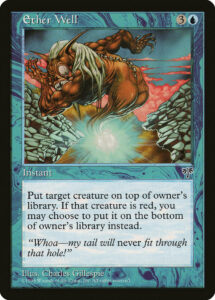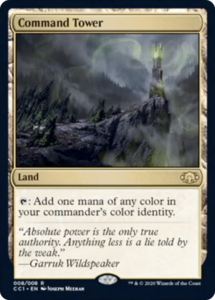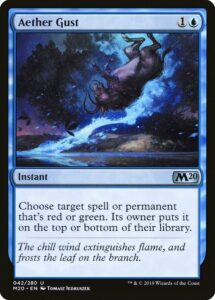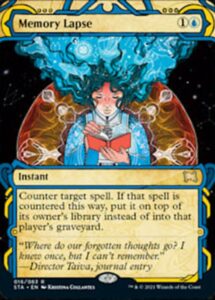It’s been a long time since we’ve seen a card like Ether Well.
This is a simple but powerful effect. Either you get Time Ebb, temporarily delaying an effect and denying your opponent a fresh card draw; or you tuck their threat on the bottom of their library. It’s been a while since we’ve seen a new card like Ether Well, Hinder, Spin into Myth, or Jace, the Mind Sculptor. Instead, we get cards like this:
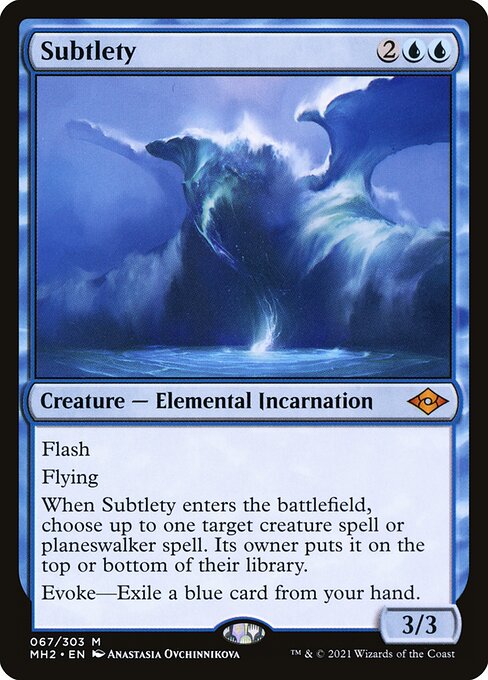
Where once you had the choice of controlling your opponent’s next draw or effectively exiling their card (barring shuffle effects), now you instead give your opponent that choice. Contemporary Magic has trended towards a higher power level and avoiding foisting unpleasant choices onto your opponent—yet in this specific design vein, Magic bucks these trends. In fact, there have been several new designs of this sort in the past few years despite the mechanic being used sparingly in the past.
Aetherspouts pioneered this design space in 2014, giving your opponent the choice so as not to be a blue, no-downside Settle the Wreckage (though it sort of is anyway). 2019 introduced Aether Gust, one of the most powerful blue hosers ever printed. Magic premiered its first common with this mechanic in 2021’s Run Ashore. And now Modern Horizons 2 will soon add Subtlety, a powerful mix of No Escape, Aether Gust, and Force of Negation.
One might reasonably ask why Magic embraced Aether Gusts and eschewed Ether Wells. The answer initially seemed obvious: Commander. Tucking was the most effective means of removing a Commander and could absolutely devastate decks reliant on their Commander, so of course Wizards redeveloped the ability to be more Commander-friendly. That explanation makes sense but can’t possibly be correct.
Commander tucking was removed in 2015—the year after Aetherspouts came out and four years before 2019 introduced Aether Gust and its ilk. Wizards works far in advance, but not that far. If they were apprehensive of using tucking because of Commander, nothing was stopping them from making Ether Wells after 2017 and foregoing the Aetherspouts precedent. So the explanation needs to be something else.
One possible explanation is psychological. Counterspells are a staple effect in Magic, but they are deeply disliked by sizable portions of Magic’s playerbase. Cards like Subtlety remove the pain of seeing your card move directly from the stack to the graveyard. Instead, you can choose to see it again immediately or much later—yes, bottoming the card is effectively the same as never seeing it again, but it doesn’t feel the same (especially if you’re not a Spike). This makes sense for counterspells Subtlety and Aether Gust, but not for Run Ashore.
A second explanation is power. Having total control of whether a card goes to the top or bottom is simply too much power, rendering the effect too expensive to use with any regularity. Heck, even the Time Ebb effect itself is too strong to use in any volume. By instead giving your opponent the choice and weakening the effect, suddenly topping and tucking cards can not only get printed, but they can be used with greater regularity and at much more aggressive costs. Aether Gust would never have been printed at two mana if the caster made the choice, and it would never have become the multi-format all-star it is at three mana.
The third and final explanation we’ll consider is color balance. Contemporary Magic gives all five colors access to suites of removal. Long gone are the days were blue was mostly restricted to bounce and countermagic. In Limited, every color gets multiple kinds of creature removal. Commander requires much the same, since Commanders can’t splash for effects they need. That’s why blue now annually receives Frost Breaths, Malfunctions, and Reality Shifts (though Reshape effects may soon be leaving blue’s color pie). Tucking/topping is simply another tool blue can use to answer opposing threats in a world where it needs several such cards every year.
It’s unclear what the future of tucking/topping cards will be. While we’ve seen several new designs in the past two years, there haven’t been many. One could imagine a world where it becomes a common alternative to bounce effects, but one could just as easily see Magic split the difference and take all choice away by printing more cards like Burying in Books, or Magic could simply continue to sparingly use tucking/topping.
There’s certainly danger in using such a powerful effect, but there’s also a need for it given how much weaker enchantment-based removal like Capture Sphere has become and how tempo-dependent Unsummon effects are. Until then, all we can do is wait and see what new tools and solutions Magic invents to address each new product’s design challenges.
Zachary Barash is a New York City-based game designer and the commissioner of Team Draft League. He designs for Kingdom Death: Monster, has a Game Design MFA from the NYU Game Center, and does freelance game design. When the stars align, he streams Magic (but the stars align way less often than he’d like).

